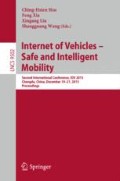Abstract
A connected car is the most successful thing in the era of Internet of Things (IoT). The connections between vehicles and networks grow and provide more convenience to users. However, vehicles become exposed to malicious attacks from outside. Therefore, a connected car now needs strong safeguard to protect malicious attacks that can cause security and safety problems at the same time. In this paper, we proposed a method to detect the anomalous status of vehicles. We extracted the in-vehicle traffic data from the well-known commercial car and performed the one-way ANOVA test. As a result, our statistical-based detection method can distinguish the abnormal status of the connected cars in IoT environment.
Access this chapter
Tax calculation will be finalised at checkout
Purchases are for personal use only
Notes
- 1.
- 2.
Engine-related = Intake air pressure (kPa) \(+\) Calculated load value (%) \(+\) Engine torque \(+\) Accelerator position (%) \(+\) Flywheel torque (Nm) \(+\) Fuel consumption (mcc).
References
Seo, S.H., Lee, S.W., Hwang, S.H., Jeon, J.W.: Development of network gateway between CAN and FlexRay protocols for ECU embedded systems. In: International Joint Conference SICE-ICASE, pp. 2256–2261. IEEE (2006)
Kleberger, P., Olovsson, T., Jonsson, E.: Security aspects of the in-vehicle network in the connected car. In: 2011 IEEE Intelligent Vehicles Symposium (IV), pp. 528–533. IEEE (2011)
Koscher, K., Czeskis, A., Roesner, F., Patel, S., Kohno, T., Checkoway, S., McCoy, D., Kantor, B., Anderson, D., Shacham, H., Savage, S.: Experimental security analysis of a modern automobile. In: IEEE Symposium on Security and Privacy (SP), pp. 447–462. IEEE (2010)
Checkoway, S., McCoy, D., Kantor, B., Anderson, D., Shacham, H., Savage, S., Koscher, K., Czeskis, A., Roesner, F., Patel, S., Kohno, T.: Comprehensive experimental analyses of automotive attack surfaces. In: USENIX Security Symposium (2011)
Kolios, P., Panayiotou, C., Ellinas, G.: ExTraCT: expediting offloading transfers through intervehicle communication transmissions. IEEE Trans. Intell. Transp. Syst. 16, 1238–1248 (2014)
Henniger, O., Ruddle, A., Seudi, H., Weyl, B., Wolf, M., Wollinger, T.: Securing vehicular on-board IT systems: The EVITA project. In: VDI/VW Automotive Security Conference (2009)
Car-hacking: Remote access and other security issues - Computerworld (2012)
Hack the diagnostics connector, steal yourself a BMW in 3 minutes - Extreme Tech (2012)
Miller, C., Valasek, C.: Adventures in automotive networks and control units. In: DEF CON 21 Hacking Conference. Las Vegas, NV: DEFCON (2013)
Oka, D.K., Furue, T., Langenhop, L., Nishimura, T.: Survey of vehicle IoT bluetooth devices. In: IEEE 7th International Conference on Service-Oriented Computing and Applications (SOCA), pp. 260–264. IEEE (2014)
Miller, C., Valasek, C.: A survey of remote automotive attack surfaces. Black Hat USA (2014)
Poulsen, K.: Hacker disables more than 100 cars remotely. Internet (2010). http://www.wired.com/threatlevel/2010/03/hacker-bricks-cars
Hackers steal Subaru Outback with smartphone, USA Today (2011)
Hack of telematics device lets attackers, Car Driver (2011)
Strobel, D., Driessen, B., Kasper, T., Leander, G., Oswald, D., Schellenberg, F., Paar, C.: Fuming acid and cryptanalysis: handy tools for overcoming a digital locking and access control system. In: Canetti, R., Garay, J.A. (eds.) CRYPTO 2013, Part I. LNCS, vol. 8042, pp. 147–164. Springer, Heidelberg (2013)
7 On Your Side: How cars can get hacked, ABC7news (2013)
Verdult, R., Garcia, F.D., Balasch, J.: Gone in 360 seconds: Hijacking with Hitag2. In: Proceedings of the 21st USENIX Conference on Security Symposium, pp. 37–37. USENIX Association (2012)
Roufa, I., Miller, R., Mustafaa, H., Taylora, T., Oh, S., Xua, W., Gruteserb, M., Trappeb, W., Seskarb, I.: Security and privacy vulnerabilities of in-car wireless networks: A tire pressure monitoring system case study. In: 19th USENIX Security Symposium, Washington DC, pp. 11–13. (2010)
Larson, U.E., Nilsson, D.K., Jonsson, E.: An approach to specification-based attack detection for in-vehicle networks. In: 2008 IEEE Intelligent Vehicles Symposium, pp. 220–225. IEEE (2008)
Hoppe, T., Kiltz, S., Dittmann, J.: Applying intrusion detection to automotive IT-early insights and remaining challenges. J. Inf. Assur. Secur. (JIAS) 4, 226–235 (2009)
OBD-II scan program, The Carbigs program supports the safety diagnosis and the driving record for all of the type of car of Hyundai-Kia Motor Group produced since (2004)
Acknowledgments
This work was supported by Samsung Research Funding Center of Samsung Electronics under Project Number SRFC-TB1403-00.
Author information
Authors and Affiliations
Corresponding author
Editor information
Editors and Affiliations
Rights and permissions
Copyright information
© 2015 Springer International Publishing Switzerland
About this paper
Cite this paper
Han, M.L., Lee, J., Kang, A.R., Kang, S., Park, J.K., Kim, H.K. (2015). A Statistical-Based Anomaly Detection Method for Connected Cars in Internet of Things Environment. In: Hsu, CH., Xia, F., Liu, X., Wang, S. (eds) Internet of Vehicles - Safe and Intelligent Mobility. IOV 2015. Lecture Notes in Computer Science(), vol 9502. Springer, Cham. https://doi.org/10.1007/978-3-319-27293-1_9
Download citation
DOI: https://doi.org/10.1007/978-3-319-27293-1_9
Published:
Publisher Name: Springer, Cham
Print ISBN: 978-3-319-27292-4
Online ISBN: 978-3-319-27293-1
eBook Packages: Computer ScienceComputer Science (R0)

